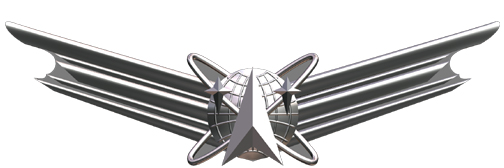Badges, Patches, Pins, Coins and More Anything involved with the military has a lot of symbols, represented by badges, patches and in other ways. For Missileers, the most important single item is now a six version badge, once called the Guided Missile Insignia, which has been renamed several times. Since the early 1990s, the Air Force has added more badges to represent every career field, and there have been specialized badges authorized during various periods of our history. Every unit has an emblem and a unit patch, and there are very many more unofficial, commemorative or special event patches that appear. The once limited tradition of challenge coins has spread throughout the services, and it seems there are now lapel pins to commemorate almost everything. |
The Missile Badge It began as the U. S. Air Force Guided Missile Insignia, a simple badge in one version, which was first issued in 1958 to two senior sergeants and two officers in two special ceremonies before all those Missileers who qualified for the new badge were awarded theirs a day or two later. It wasn't just for launch officers or maintainers; it was for maintainers, all those officer and enlisted members involved with the new Air Force missile systems. A few years later, a star and a star within a wreath were added to the top of the badge to indicate experience levels, and the badge became the Missileman's Badge. When the badge was 30 years old, it was decided that the operators (launch officers) needed special recognition, so a second, larger wreath was added around the badge, and it was now called the Missile Badge or the Missile Badge with Operations Designator. A few years after the ICBM force moved to Air Force Space Command, the decision was made to combine the Space and Missile Operations career fields, and replace the Missile Badge with Operations Designator with the new Space Badge. Between 2005 and 2007, new missile operators were awarded the Space Badge, with the Missile Badge only awarded to those in Missile Maintenance and related fields. In December 2007, the Missile Badge with Operations Designator was returned to the uniform and the Space Badge no longer awarded. The version without the Operations Designator was renamed the Missile Maintenance Badge. This new nomenclature has caused some misunderstanding among newer operators, making them think that the only Missileers are the operators, that the term Missileer does no apply to maintainers or other specialties - which is the opposite of the historical roots of the term. One of AAFM's long time members, Greg Ogletree, put together an excellent, detailed history of the missile badge. You can link to that history on Missile Badge page of our web page on the History tab above. |
|







.jpg)

.jpg)